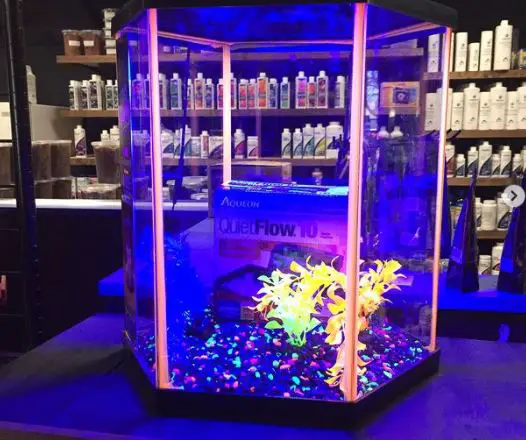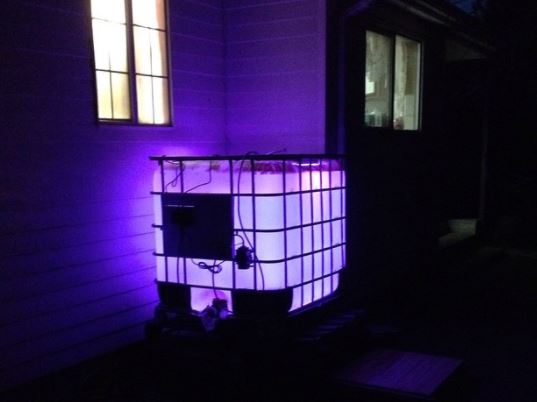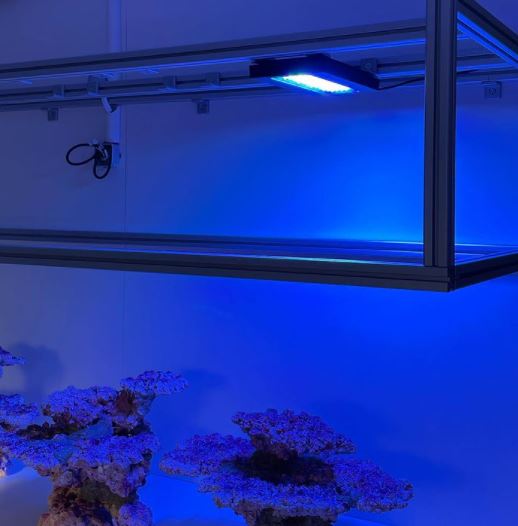Can LED lights be used for reptiles? You may not know this, but you can use LED lights for your reptiles!
Many people believe that what all reptile owners need to do is provide a heat source and they are good to go.
But what if you want something more than just the basics? You might be thinking, “What does an LED light offer me?”
Let us find out.
Related Posts:
- Best Plants for Bearded Dragons You Should Know
- 7 Best Heat Lamps for Tortoise
- Top 7 Best UVB Bulbs for a Sulcata Tortoise
Can LED Lights Be Used for Reptiles?
The answer is yes. An LED light can offer you a lot, especially if you want to get more creative with your reptile habitat.
For instance, you can use an LED setup for both night and day! By providing two different lights during the day and at night, your animals will be able to see better in their tank.
Even within a 24-hour period, they will have a better sense of time with an LED cycle.
You may even be able to train your reptiles to eat at certain times!
Why Are LED Lights Important for Reptiles?
Most reptiles are nocturnal, which means that they are active during the night. However, there are some species that are more active during the day.
By turning your LED light cycles to mimic natural daylight, you may be able to decrease stress levels in these “daytime” reptiles, which can help with overall health.
When setting up an LED light for your reptile tank, it is important to know that not all animals like the same color lights.

Many reptiles are either nocturnal or active during dusk and dawn, which means that they need to be able to see in the dark.
They will instinctively hide from predators, so it is important that you provide these animals with an LED light that provides a “nighttime” cycle.
This doesn’t mean that you necessarily have to switch your lights off at night. It just means that you need to provide a different color light.
But what about the animals that are diurnal? In this case, you will want to mimic natural daylight as much as possible.
You can do this by providing your animals with white or blue light during the day and then switching the lights off at night.
What Are White Python LED Lights?
White Python LED lights are specifically designed to provide light, coloring, and heat for your reptiles. At 5 feet long, they are the perfect size for most reptile tanks.
They include two different modes.
First is a regular day cycle with red lighting at night to mimic dusk and dawn. Your animal will feel more comfortable knowing that there is still some light in the room, even if you are sleeping.
The other mode is a nighttime cycle that provides deep blue light to help your animal sleep naturally.

The lights are easy to install with an included on/off switch, but they also come with an automatic timer that turns the light on and off at specific times.
You can set it for 7 to 12 hours on, and 4 to 7 hours off time. This will help you save money on energy costs while keeping your reptile happy.
You can purchase a White Python LED light here. There is a two-year warranty to protect your purchase.
How to Install LED Strip Lights for Reptiles?
Now that you know why you would want to use an LED light, let us talk about how to actually do it.
The first thing you need to know is that there are some specific requirements for an LED bulb.
LEDs use a lot of power, so if they get too hot, the fixture itself could burn your reptile.
When shopping for an LED light, it’s also important to keep in mind that reptile tanks are usually deep, so you would want to make sure you have a long strip light.
For a day cycle, try using 135-lumen white or blue LEDs. For a night cycle, use 72 lumen red LEDs.
These numbers may vary depending on the size of the tank and the density of your reptile’s feces, but they are generally a safe bet.
Please be aware that some specific reptiles (such as chameleons) may not like lights that change color too often!
At night or during certain times of day, you can adjust your LED light to mimic natural lighting with little to no color change.
Just like humans, reptiles like to have a sense of consistency in their habitat.
Will LED Lights Affect a Snake?
Another question that people commonly ask is, “Will LED lights affect snakes?” The answer to this specific question will vary depending on the snake.
While some reptiles may like the color blue, others might not.
Some reptiles are afraid of red lights because it is similar to a predator’s eyes, so if you want your snake to be comfortable, try using a white LED light.
If you are not sure, just opt for a regular bulb and then try switching it out later!
Can You Use a Chicken Heat Lamp for Reptiles?
Yes, the bulbs do not make any light, so animals are not disturbed. The lights can be used for reptiles, amphibians, birds, and personal use.
Some reptiles are ectothermic, which means that they rely on the temperature of their environment to control their body temperature.
For these animals, you would need to use a heating lamp instead! The best type of heat lamp is a red or infrared tube light.
This will provide your reptile with plenty of warmth without sacrificing too much visibility in the tank.
You should always be sure to follow the specific needs of your reptile. If you have any questions about lighting, contact a qualified veterinarian!
A good rule of thumb is to stick with regular lamps for heating and LED lights for the cycle, so you know that your reptile has something on at all times.

Conclusion
If you have a reptile, chances are they need to be under some form of light. While many people use heat lamps for this purpose, there is an alternative: LED lights!
LED lights can be used for reptiles. They can provide the same level of lighting that reptiles need without heating up the room as traditional bulbs do.
Plus, LEDs don’t emit UV rays, which makes them safer than other types of light sources around your pet.
Key points for using led lights for reptiles:
LED lights have gained popularity in reptile husbandry due to their energy efficiency, versatility, and spectrum options. Here’s a concise guide to using LED lights for reptiles, presented in bullet points for quick reference:
1. Energy Efficiency:
- Cost-Effective: LED lights consume significantly less energy compared to traditional lighting options, resulting in lower electricity bills.
2. Spectrum Options:
- Customized Lighting: LED lights come in various spectrums, allowing you to tailor the lighting to meet your reptile’s specific needs, such as UVB or plant growth.
3. UVB Production:
- Dedicated UVB LEDs: Some LED fixtures are designed to emit UVB light, which is crucial for reptiles that require UVB exposure for calcium metabolism and overall health.
4. Heat Emission:
- Low Heat Output: LED lights produce minimal heat, making them safe to use in reptile enclosures without causing overheating issues.
5. Longevity:
- Extended Lifespan: LEDs have a significantly longer lifespan compared to other lighting options, reducing the frequency of bulb replacements.
6. Dimmable and Programmable:
- Controlled Light Levels: Many LED fixtures offer dimming and programmable options, allowing you to simulate natural day-night cycles and adjust brightness as needed.
7. Versatility:
- Suitable for Various Reptiles: LED lights can be used for a wide range of reptile species, including those with specific lighting requirements.
8. Reducing Stress:
- Smooth Transitions: The gradual dimming and programmable features of LED lights help reduce stress when transitioning between light and dark periods.
9. Aesthetics:
- Enhancing Enclosure Appearance: LEDs can enhance the visual appeal of your reptile’s habitat, creating a more aesthetically pleasing environment.
10. Brand and Quality:
- Reliable Manufacturers: Choose LED fixtures from reputable manufacturers or brands that offer quality products and back them with warranties.
11. UVB Exposure:
- Supplement When Necessary: While some LED lights emit UVB, not all do, so check if your reptile species requires additional UVB exposure.
12. Individual Reptile Requirements:
- Know Your Species: Different reptile species have unique lighting needs. Research and understand your reptile’s specific requirements to choose the appropriate LED setup.
13. Proper Installation:
- Positioning Matters: Place the LED fixtures at the correct distance and angle within the enclosure to ensure your reptile receives the right amount of light.
14. Regular Monitoring:
- Check for Functionality: Periodically inspect your LED lights to ensure they are working correctly, especially if they emit UVB.
15. Reptile Behavior:
- Observe Your Reptile: Monitor your reptile’s behavior and adjust the lighting schedule or intensity if you notice any adverse effects or changes.
Using LED lights for reptiles offers several advantages, including energy efficiency, spectrum customization, and reduced heat emission. It’s essential to choose the right LED fixture for your reptile’s specific requirements and provide them with a comfortable and well-illuminated habitat. Regular monitoring and understanding your reptile’s behavior can help ensure they benefit from the advantages of LED lighting.
Further Reading:
- 7 Best Lighting for Chameleons
- 9 Best Heat Lamps for Bearded Dragons
- 5 Best Bearded Dragon Lighting Setups
- Best UVB Bulb for Sulcata Tortoise


